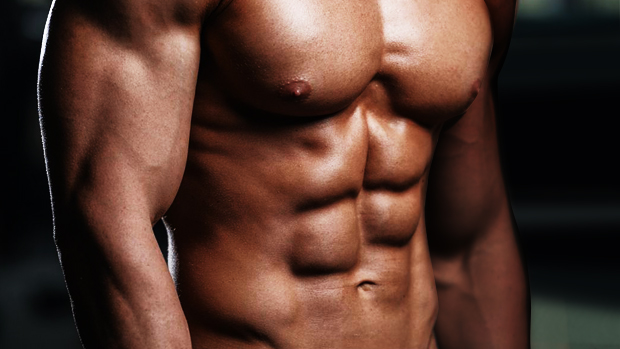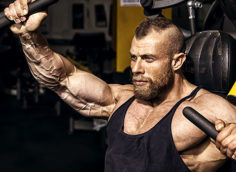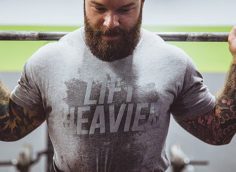To build a strong, athletic body you can't skip out on core training. It may be the one thing that's holding back your progress. But to train the core for performance, you need to address its main functions.
- Transfer force between the feet and hands
- Transfer force where you want the force to go
- Transfer force without energy leaks
When you've trained the core the way it's meant to be trained, you'll run faster, jump longer and higher, throw further, strike harder, and simply be a strong, resilient beast in your sport. A strong core will also keep your spine and body healthier. It's vital for both performance and health.
You can perform thousands of different ab and core exercises. But I'm a strong proponent of keeping the spine rigid while the hips, legs, and arms move. This doesn't mean that I'm against spinal flexion, sit-up variations, etc. I simply see more direct carryover to performance from training the ability to let the hips, shoulders and arms do the movement while the spine stays mostly rigid.
The regular plank is a fine exercise to teach core stability and the ability to generate full body tension. (If you're going to do them, look up the RKC version.)
Once you've mastered the regular plank, it's time to introduce a more reactive version. During functional movements and sports, the core has to respond, not simply work in and from a passive position. This exercise will teach you to respond and react by creating stability and stiffness.
To do it, start by moving the hips up and down slowly. Then "jump" up so the feet lift from the floor. When you land, you instantly want to stick the landing in a regular tight plank position. When you've got this down, jump and land in a rotated position, switching sides from rep to rep.
To be explosive you have to be able to go from ON to OFF and back to ON again. The faster you can go from active to relaxed, and from relaxed to tight, the better it is for your athletic ability. Master this and your performance will increase.
This is the plank's forgotten sidekick. That's not good because too much focus on the front side of the body (by doing only regular planks) will lead to a big gap in your core strength. Without directly loading the sides, you'll leave a hole in your performance.
You've probably never done REAL side planks. I can say this because I've watched hundred of athletes do them and they all compensate, rotate, and/or flex their hips. Why? Because their core muscles are weak in this area.
Most people struggle with the bulletproof side plank in the beginning because it forces you to use the right muscles. It's simply hard to cheat this exercise!
With the bulletproof side plank, your heels, butt, and shoulders must be touching the wall. Your elbow can be placed a bit out from the wall for stability. The head will preferably touch, but if you have neck issues it can remain wherever it's most comfortable.
The first step is to be able to hold the position for at least 30 seconds. When this is mastered, add lateral movement as shown in the video. This is a great way to train the lateral core and hip strength and stability.
Once you've mastered the moves above, you're ready for rotations. Rotation – and the ability to be its master – is the foundation for athletic performance and a healthy body. Most injuries and compensations happen because force is "leaking out" in movements. This leaking is often a result of training mainly in the sagittal and frontal plane.
For example, if you only train squats, deadlifts, lunges and side lunges, you set yourself up for failure. These are all good, but without a strong focus on rotation you self-sabotage your performance. Training rotation will automatically train and teach anti-rotation as well, especially if you're turning up the volume (the speed of execution).
To do the exercise, stand upright with a dumbbell in each hand, placed in a neutral hammer, curl-like position. From here, start to swing the dumbbells from side to side in a circular motion. The point is to accelerate, decelerate, and re-accelerate with the whole body and core engaged.
The great thing about it? It instantly teaches the importance of where the rotation force is coming from – the feet. A common cause of many problems is a lack of proper "rooting" of the feet. This exercise will reveal it.
You can either do this exercise with a "core" focus, which means you'll mainly focus on the abs/low back area, or you can integrate more hips in the movement.
In the former version, the feet are locked on the ground at all times. In the latter version, you allow your heels to come off the ground, creating movement throughout the balls of your feet. Obviously your whole body is working in both versions, but you can direct the focus where you need it. Start with feet locked in.
Mastering the regular landmine lifts instantly makes all other strength and performance training better. It requires the ability to create full body tension from a standing position, which is more "functional" for most athletes.
The next progression is to create a more reactive and explosive environment. The ability to decelerate, stabilize, and re-accelerate is key for optimal performance.
To do the athletic landmine, start with a regular landmine "full contact twist" before you create a forceful rotation and perform a side shuffle movement starting from the core and hips.
The bar coming down to the side will load the hips and core muscles, much like a coil. The purpose is to quickly and precisely stop the barbell/weight, before re-accelerating it to the other side.
Even though the exercise isn't super advanced, safe execution requires a strong core and good timing. Start light and make sure you have the regular landmine move under control. You don't want to go too heavy here. You won't get max power output with the heaviest weight.
To really feel where the force should be coming from in rotation movements, you need to increase the resistance (when you're ready for it). When using bands, Pallof presses and anti-rotation variations are a good place to start.
Once mastered, you need more violent muscle action, and this is where band rotations 2.0 are introduced. The concept of execution is similar to dumbbell core rotations, but now you focus on one side at a time.
With a decent amount of band tension to rotate against, you can really accelerate all the way. That's the main benefit of band exercises. Light bands won't really do the trick here because it's too easy to compensate with light resistance and not tense the whole body. More resistance will teach you.
To do this exercise, stand with a band held with one arm at your side. If using a band with high tension you want to hold the band close to your body. With lighter resistance, you can certainly increase the lever arm – place arm your more in front and in different angles, depending on what you're training for and need to practice.
From the starting position, generate force through the feet and hips while you rotate away from the attachment. Get speed and power throughout the rotation, activating your whole body. This happens from the feet, through the hips and core, to the hand/band. Make your body work as a unit!





